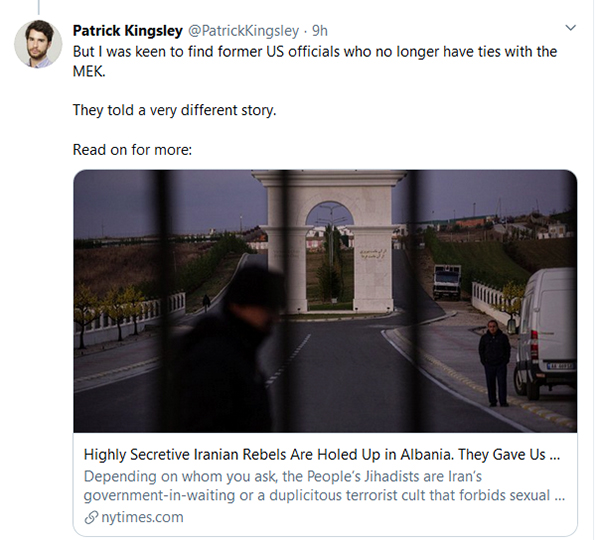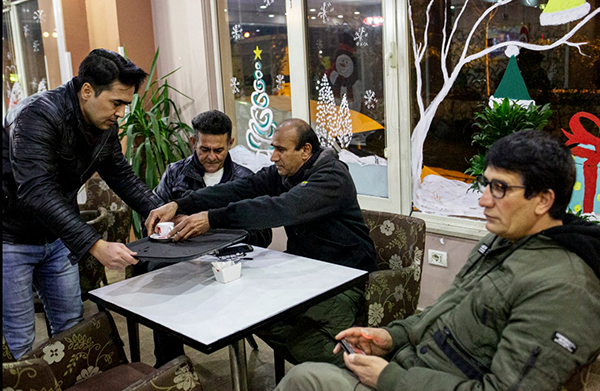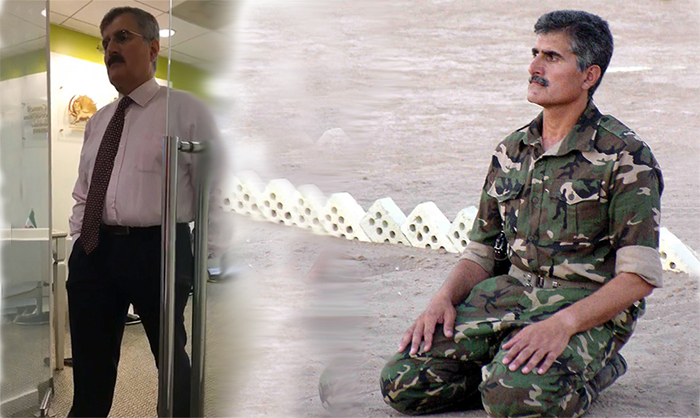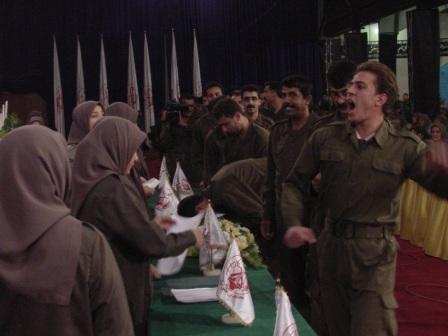Patrick Kingsley was one of the few foreigners who has been recently allowed to enter the headquarters of the Mujahedin Khalq Organization (the MEK, MKO, PMOI, NCRI, the Cult of Rajavi). He is also one of the very few journalists who could manage to walk in the”Highly Secretive”base of the group near Tirana, Albania.
During his report on the tour of newly built town, he was given the opportunity to observe the life of a few thousands Iranians living under the cult-like system of the Rajavis even though the camp’s authorities have tried their best to manipulate his perception of the life inside the system.
The New York Times journalist tries to stay unbiased on what he has heard about the group’s cult-like nature. Seemingly he is not convinced by what he is shown in the group so he tends to complete his observations in the camp with interviewing former members outside the camp. He also does not restrict his investigations to those US army officials that the MEK authorities suggest.

Eventually he finds a lot of controversy between what he was told by the group’s men and what he was told by former members and Captain Matthew Woodside, a former naval reservist who oversaw US policy in the Iraqi camp between 2004 and 2005 and who”was not one of those whom the M.E.K. suggested”that he contacts.
Sharing parts of his new article for the NY Times on tweeter, Kingsley exposes more facts about the life inside the MEK camp in Manez, Albania. He tweets:
Naturally, they all denied most of what was said about the group. They said celibacy, forced divorce and rejection of family life is just a necessary part of overthrowing the Iranian government.
One admitted the self-criticism.
One admitted it, then corrected himself.
The rest denied it
Hope the one member is OK right now. He would be lucky to survive peer pressure for the mistake he has made in front of a foreigner. It is very probable that he would be punished for tarnishing the MEK’s face for a Western journalist.

Patrick Kingsley brings the testimonies of ten former members now live independently in Albania”each of whom described being brainwashed in a celibate life“.”In the group, they stated that romantic relationships and sexual thoughts were prohibited, family contact very limited and friendships discouraged”, he clarifies.

And, he verifies that self-criticism is part of the MEK’s ruling system.”All of them said they were forced to participate in self-criticism rituals, in which members confessed to their commanders about any sexual or dishonest thought they had,”he writes.
“The oddest moment came when I asked about Massoud Rajavi, who hasn’t been seen since 2003, and whom former members say is the subject of cult-like reverence,”Kingsley tweeted about this part of his report:
In particular, senior officials stumbled when asked where the group’s leader, Massoud Rajavi, who disappeared in 2003, was.
“Where is he? Said Ali Safavi, the group’s main representative in Washington.”Well, we can’t talk about it, it’s …”
He paused, staring at his feet.
Is he still alive? Is he in Albania?
“We can’t talk about it,”said Safavi, after being silent for a few seconds. of several seconds of silence.
Ali Safavi is one of the MEK’s propaganda commanders. He is the group’s figure who runs the group’s propaganda in Western media. The group authorities chose him to deal with the NY Times correspondent probably because of his long time experience in working with English language media.

However, Safavi was not able to answer the simplest question about the whereabouts of the group’s leader Massoud Rajavi.
This is the bottom line of the entire report. The MEK’s leader has been disappeared for near two decades. No one is allowed to ask about his whereabouts. No one is allowed to answer about his whereabouts. This is absolutely a cult-like system that no one should know that its everlasting leader is sick or dead or something.



1 comment
Great peice!
I read the NY Times too. It was really unbiased and realistic about the world inside the MEK.